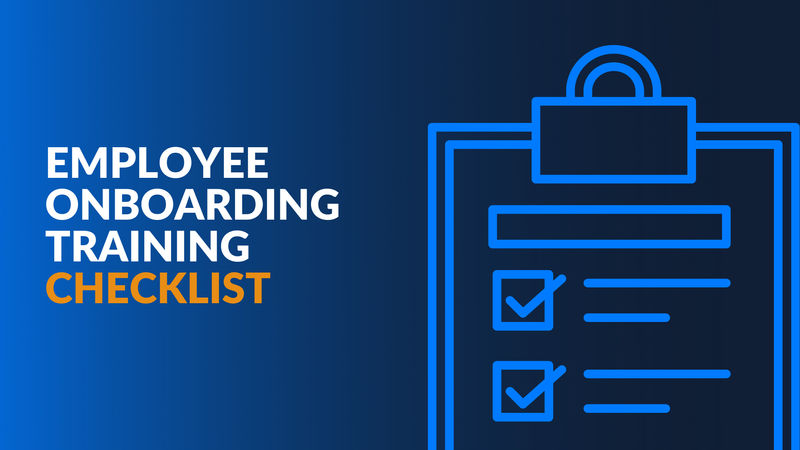
Employee Onboarding Training Checklist
Posted on 02/22/21 By Brittany K. King
New employees often show up on their first day eager to get started in their role. But before they get to work, new hires should undergo a thorough employee onboarding training process to ensure they start their jobs on the right foot.
What should be included on a new employee onboarding checklist? Which training topics need to be covered on an employee’s first day? And what about onboarding remote employees?
You’ll find the answers to all of your employee onboarding training questions (and more!) below.
New Employee Onboarding Checklist
There are a lot of moving pieces to monitor when onboarding a new employee. It’s important not to let any critical onboarding items to fall through the cracks.
The sample onboarding checklist below will help you keep track of the training your new employee needs upon starting.

1. Company Policies
The first step in employee onboarding training is usually standard new hire paperwork. At this point in the onboarding process, you should take time to introduce the new hire to other employees, managers, and key stakeholders they should know.
Review your specific company guidelines and fill out employment forms, including:
- Compensation and benefits
- Individual job responsibilities
- Termination conditions
- Employment eligibility forms (Form I-9)
- State tax withholding forms (State W-4)
- Direct deposit
- Non-compete agreements
- Employee handbook
- Emergency contacts and medical history
2. Compliance Training
Compliance training is a critical step in your employee onboarding process to make sure new hires are ready for work on day one.
New employee training should consist of anti-discrimination and harassment topics, as well as general safety and industry-mandated topics such as:
- Diversity and inclusion
- Sexual harassment
- Unconscious bias
- Ethics
- Violence prevention
- Fire safety
- Health resources
- Cybersecurity
- Risk management
- HIPAA compliance
3. Technical Skills Training
Technical skills training is another important part of employee onboarding. This training will help the new hire learn or strengthen skills they need in order to perform their specific job duties.
You can also have new hires complete certifications for programs or capabilities relevant to your organization.
Examples of hard skills include:
- Computer software
- Microsoft Office
- Analytics or reporting
- Management or leadership
- Project management
- Database management
4. Interpersonal Skills Training
One of the most overlooked steps on new employee onboarding checklists is interpersonal, or soft, skills training.
Employees need soft skills training to enhance how they communicate, adapt, and operate in the workplace.
Common soft skills training topics include:
- Empathy
- Time management
- Teamwork
- Written & oral communication
- Critical thinking
- Problem-solving
Remote Employee Onboarding Checklist
The onboarding checklist for remote employees should be identical to the one used for on-site workers. However, this checklist will include a few extra items needed to accommodate those who work from home.
When onboarding remote employees you should provide them with all of the items you would normally supply in an office, such as:
- Computer or laptop
- Monitors, keyboard, mouse, and other computer accessories
- Printer or scanner
- Company phone
- Paper, notebooks, pens, and other desk essentials

More Tips for Employee Onboarding Training
Aside from the items on your new employee onboarding checklist, there are additional steps you can take to ensure a smooth onboarding process.
Here are other ways you can strengthen your new employee onboarding training:
- Designate a mentor or point of contact to new employees to help them integrate into the company culture.
- Check in regularly to ensure the new employee is making progress with their onboarding training.
- Encourage them to review or redo training until they feel comfortable with the topic.
- Repeat the onboarding checklist regularly. Company policies and compliance training should be revisited periodically while skills training should be ongoing for every employee.
Your employee training program should support all of your needs, from onboarding to upskilling. Achieve your organization’s goals with Lorman’s Team & Enterprise Training solutions.
Related Articles
Preventing workplace violence is a key part of employee safety. It's important to have policies and education in place to reduce violence and promote safety in the workplace.
In today's rapidly evolving work environment, ensuring a safe and inclusive workplace is of paramount importance. To help create such an environment, organizations must prioritize workplace sexual harassment training. By providing employees with the neces
Engagement surveys are one of the most valuable tools for an organization, yet are often underutilized. There are many benefits of employee engagement surveys, which is why companies should consider making it a standard practice.


.png)